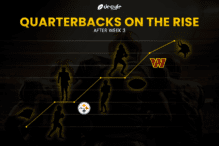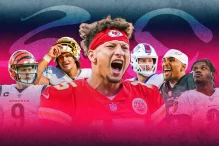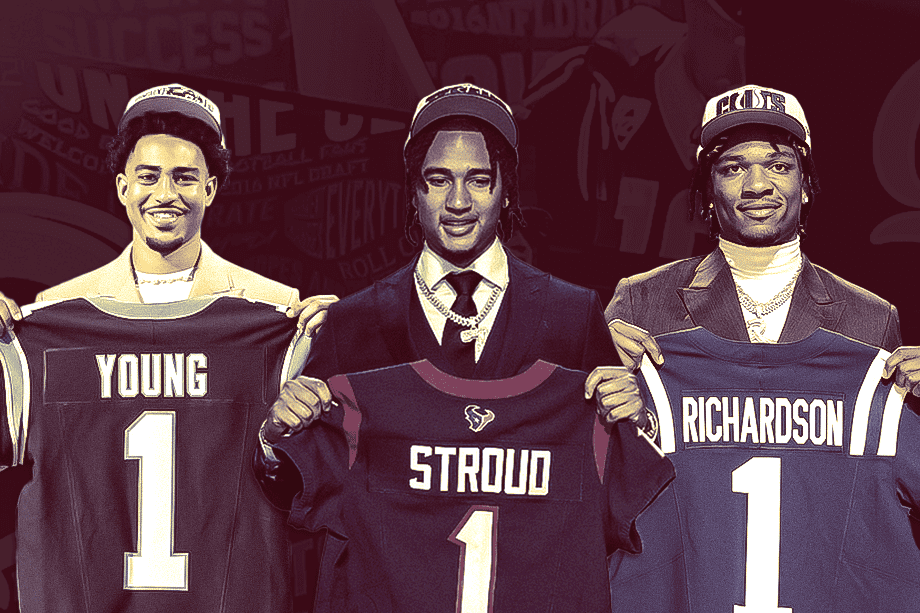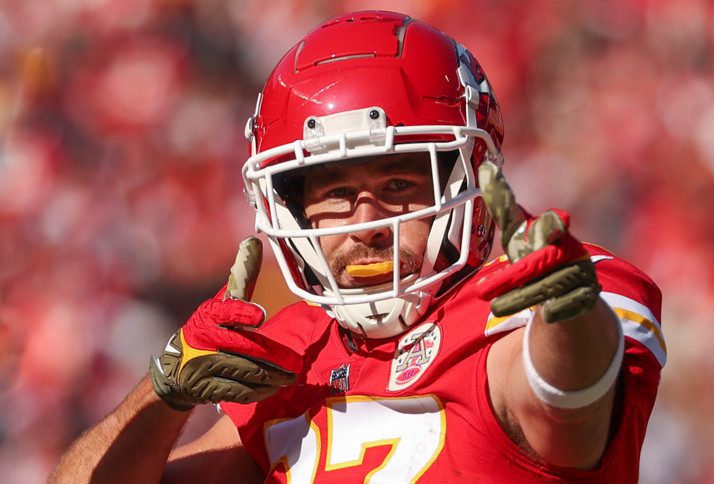

With the 2024 NFL Draft fast approaching, college prospects desperately hope to capitalise on every remaining opportunity to impress scouts, coaches and executives from all of the league’s 32 teams.
Every year, a key fixture in the build-up to the Draft is the NFL Scouting Combine – providing prospects with a vital chance to prove why they are the right fit and worthy of selection come Draft Day.
With attendees making their way home following yesterday’s conclusion of the 2024 NFL Scouting Combine, Decyfr breaks down what the combine is, how it came to be and how crucial it is in a team’s prospect evaluation process.
What is the Combine?
Described on their official website as an “intense, four-day job interview”, the invitation-only event provides teams with a unique opportunity to evaluate around 300 of college football’s top athletes, as they look to make their NFL dream a reality.
The combine consists primarily of three main components:
- Interviews and psychological evaluations
- Medical examinations
- Athletic evaluations
Here are the key dates ahead of the 2024 NFL Draft 🗓️#Decyfr #NFL #NFLUK pic.twitter.com/XtRKsRWWHg
— Decyfr Sport (@DecyfrSport) February 19, 2024
1 – Interviews and psychological evaluations
Over the course of the four-days, each team conducts up to 60 interviews lasting 15-minutes each, with players of their choosing. Within these 15 minutes, scouts and coaches aim to gain the greatest possible insight into the mental capabilities of the player – testing their ability to cope with pressure, retain information and quickly apply that which they have learnt.
Speaking on the interview process, Indianapolis Colts general manager Chris Ballard said: “The interview session is really an introductory period. We hand it over to our coaches; we let them have that 15 to 20 minutes.
“We want to be able stress them – let’s stress them intellectually and let’s see what they know.”
Commonly, this process of ‘stressing them intellectually’ entails a coach teaching the prospect an entire concept or play before asking them to recall every detail of said play whilst answering additional questions.
Furthermore, prospects are required to undertake the ‘S2 test’. The S2 test, which recently replaced the ‘Wonderlic test’, is used to test a player’s ability to track multiple objects, make complex decisions, and quickly dissect information.
2 – Medical examinations
The last thing that a team wants is to draft a player and immediately discover a host of medical issues that impact their performance or longevity. As a result, each prospect undertaking a thorough medical examination is seen by many as the most important part of the combine.
After reviewing each player’s medical history – which is “updated by physicians, athletic trainers and other specialists throughout their college careers” and “stored in an NFL/NCAA database”, as per NFL Football Operations – additional tests, specific to that player, are then carried out.
To establish how extensive these tests are, President of National Football Scouting, Jeff Foster said: “In 2013, we did 365 MRIs on 333 players in four days.”
3 – Physical evaluations
While not as important as the other two elements of the combine, the physical evaluation is by far the most famous and widely celebrated – with workouts being broadcast live to millions of viewers every year.
Grouped according to their position, players complete a series of workouts that showcase their athletic abilities when performing game-like actions.
40-yard dash – Including 10-yard split
- From static, the player runs 40 yards as fast as possible. The 10-yard split is the time taken to complete the first 10 yards – assessing a player’s acceleration.
Broad Jump
- From standing the player jumps forward – ensuring they land on their feet.
Vertical Jump
- From standing, the player jumps vertically, with the peak of the jump marked by the top of their fingertips.
3-cone drill
- Players run around three cones laid out in an L-shape – testing one’s quickness and ability to change direction.
20-yard shuttle
- From static, stood in the middle of three lines, the player touches the line to their right, then the line to their left and finally sprints back to the starting point – testing one’s lateral quickness.
Bench Press
- Players bench 225 lbs for as many reps as possible – indicating a player’s upper body strength.
Position-specific drills
- Players are led through specific drills depending on their position.
Stephen Paea 🆚 World's Strongest Man#Decyfr #NFL #NFLCombine pic.twitter.com/qWVSjSA6m3
— Decyfr Sport (@DecyfrSport) March 1, 2024
Additionally, players will have their measurements taken – which, while seemingly minor, can have a significant impact on a player’s draft stock. For example, Pittsburgh Steelers quarterback Kenny Pickett faced a lot of criticism due to the size of his hands – given the necessity of a QB’s grip on the ball.
While this stage of the combine presents teams with a unique opportunity to directly compare prospects in terms of their key athletic traits, “most evaluators agree that the NFL Scouting Combine is simply to validate what they’ve seen on film,” says Foster.
How did the Combine come to be?
In 1976, the New York Jets became one of the first teams to invite NFL-eligible college players to their facility – taking them through medical testing and interviews. This process immediately paid dividends for the Jets franchise who, according to former Director of Player Personnel, Mike Hickey: “Saw seven years of draft success – with nearly half of the 36 players that the team drafted since 1977 becoming starters.”
Keen to replicate this level of success, other teams around the league quickly followed suit – resulting in prospects spending considerable amounts of time travelling between teams.
That was until Tex Schramm, former President and General Manager of the Dallas Cowboys, recommended that teams centralise the evaluation process, as per NFL Football Operations – with the first National Invitational Camp eventually being held in 1982 for 163 prospects.
From there, the combine found its permanent residence in Indianapolis before evolving into the event that we know it to be in 2024 – with the addition of electronic timing in 1999 being the final major change in its format.
How important is the Combine?
The importance of the interviews and medical evaluations are indisputable – forming a major part of every team’s overall assessment of a player. However, the importance of the workouts is contingent on a variety of factors.
For many, the opportunity to demonstrate their athletic prowess in front of representatives from all 32 teams is an essential factor in determining how early they hear their name called in the NFL Draft. That said, some players are so highly-touted coming out of college, that competing with 300+ other elite athletes could be agonisingly detrimental to their draft stock.
John Ross is a prime example of the former. Coming out of college, Ross was ranked as a top wide receiver prospect in the 2017 Draft class and viewed as a potential late first-round pick. However, upon breaking the record for the then-fastest 40-yard dash in NFL Combine history – with an incredible time of 4.22 seconds – Ross’ draft stock shot up considerably. So much so that even an injury couldn’t stop him from becoming the ninth overall pick in the Draft.
On the other hand, although he wasn’t necessarily seen as a top prospect, Puka Nacua’s incredibly poor performance at the combine caused his draft stock to plummet – notably running a 40-yard dash which ranked 34th among receivers in the 2023 Draft – causing him to fall to the 177th pick, in the fifth round.
In an attempt to avoid a similar fate, both quarterback Caleb Williams and wide receiver Marvin Harrison Jr. made the decision not to partake in the workout section of this year’s combine. With both players viewed as generational prospects, and expected to be selected in the top five, participating could likely only hinder their draft stock.
Meanwhile, wide receiver Xavier Worthy’s draft stock has experienced a turn similar to that of John Ross. After breaking Ross’ aforementioned record with a time of 4.21 seconds – Worthy became a fan favourite overnight, with many experts now touting him as a first-round pick.
Xavier Worthy OWNS the 40-yard dash 🏃♂️#Decyfr #NFL #NFLCombine | @XavierWorthy pic.twitter.com/oPN779Zo2S
— Decyfr Sport (@DecyfrSport) March 4, 2024
The challenge for Worthy – and any other prospects who’s made a name for themselves at this year’s combine – is proving that their display of athletic excellence can indeed translate to the field, in an actual game.
Recognising the impact that the combine can have on coaches and scouts around the league, prospects now spend an enormous amount of time preparing specifically for the combine – discovering the tricks and techniques required to master each workout. As a result, teams are arguably presented with a false representation of that player’s in-game athletic ability – leading to players later adopting the dreaded ‘bust’ title.
https://decyfrsport.com/nfl-101-the-scouting-combine/
Copied!































































































































